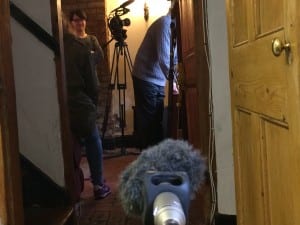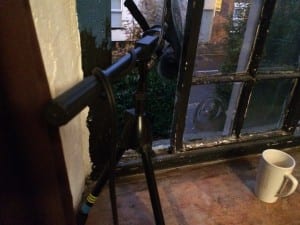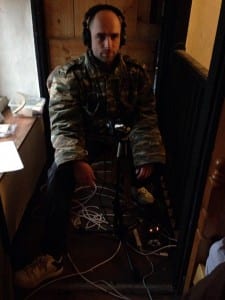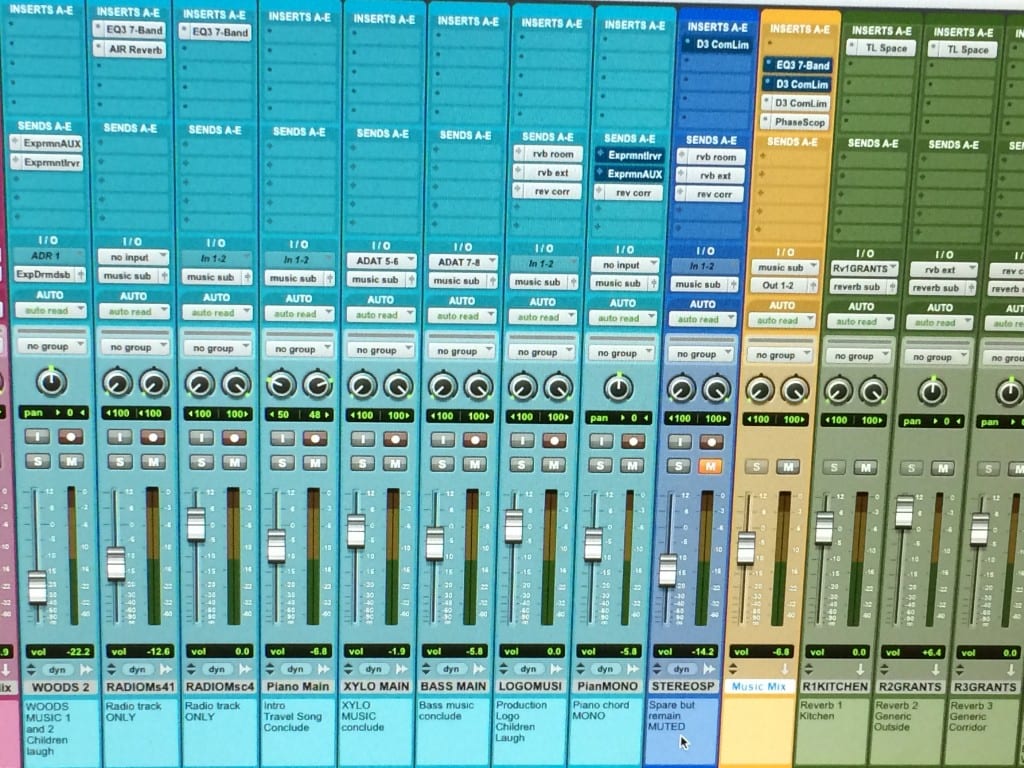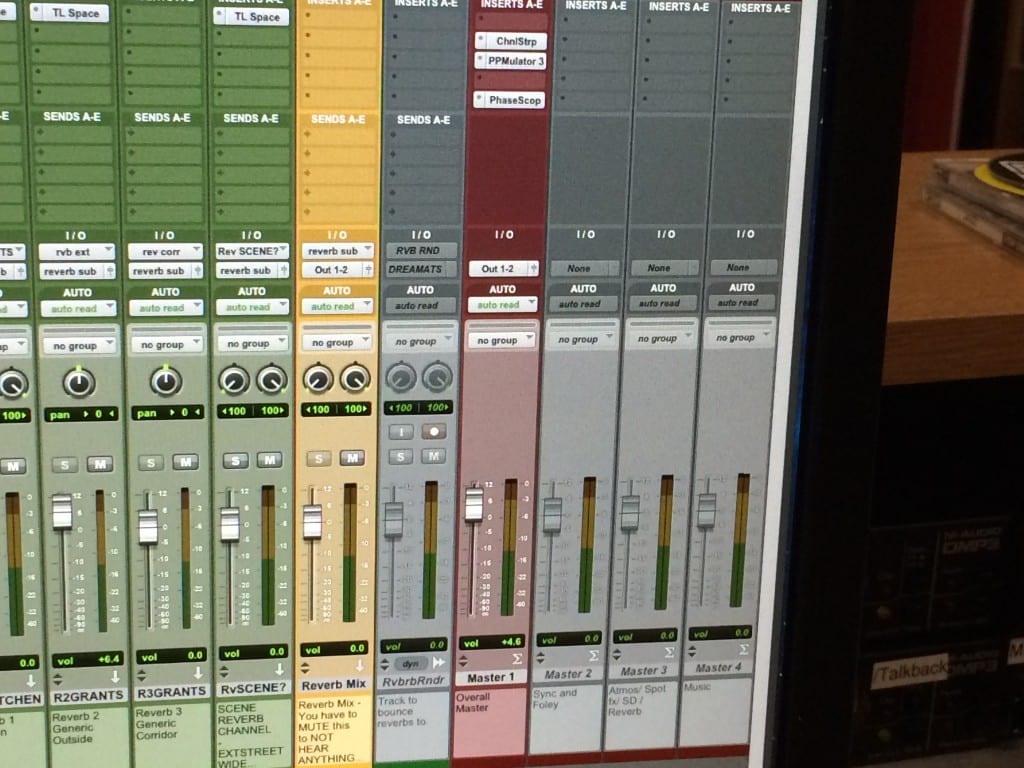03, 04, 05/11/15 – ‘George’ Set Dressing and Shoot Days 1 and 2 –
Production
The team has successfully completed the first two days of location audio recording for ‘George’ at an indoor location in uphill Lincoln. This has comprised roughly 16 hours of work time, with Rory Hunter taking the lead role as location supervisor and with Alice Asbury undertaking most of the boom op work. I have seconded Alice on the boom when required, and spent my time collecting secondary perspectives for action and dialogue, and wild tracks.
This has mostly been achieved with a combination of a PZM boundary microphone and a Rode NT4 stereo condenser, with the former recording into the main Sound Devices mixer and the latter managed by myself and recording into a Zoom handheld unit, as this enabled me to mix, manage and monitor my own audio without interfering with the main team. With these, I have consistently attempted to deliver a room / distance tone coloured by the set environment to specific action and dialogue for the picture, to enable us to have multiple audio perspective options for key scenes in post without having to build each one from scratch using FX or new foley work. An A/B example of our dialogue recording can be heard below, featuring the same scene from our “up close” boom mic and a second gleaned from a combination of secondary sources.
In terms of mic placement, I’ve found myself inverting a good deal of the technique used in studio work to avoid or cut out reverb or room-tone because that’s precisely what I’m after, and thus sticking a Rode NT4 into corners, out of windows, in corridors, stairwells and under beds…Having never handled a stereo mic or worked location audio before, this entire process was a trial and error learning experience for me. I spent much of the setup day prior to shooting listening to the rooms and testing mic positions relative to them as the production team organised the set, as well as capturing ‘base’ atmospheres and specific foley or SFX from the local environment.
Obligatory photos of the shoot –
The NT4 is a stereo mic (two capsules at 90 degrees over and under one another) and seems exceptional for ‘immersive’ captures and was often placed a considerable distance from the action, often in another room altogether. Whilst this did away with a couple of moments where I might have captured a ‘live’ stereo aspect to the action, it tended to create unusual and slightly unbalanced stereo atmospheres as the reflections travelled from room to room and struck the pair of mics relatively unevenly. I judged this would be more useful to the team later, as what little action takes place in ‘George’ can easily recreated if necessary, but that these various perspectives would be harder to obtain.
We used the boundary mic to take advantage of the exclusively stone and wood floors of the set-house – we located it under furniture for concealment, under the floorboards themselves at one stage, or either directly on the floor or taped to the underside of a table or bed. This really enabled a pre-synced and consistent ‘chunkiness’ to footsteps, furniture motion and prop motion, which I expect will come in handy later. The mic-heavy ‘live’ approach above was arrived at through a group decision as a method of getting us ahead of the game with some of our requirements for foley and atmospheres for the picture.
Logging the collected audio properly when using a second recorder was naturally critical as it lacked the convenience of being recorded in sync with the 663 audio, though this was somewhat complicated by the haphazard nature of the picture teams workflow. This necessitated annotating each days shooting scripts carefully with filenames etc, and rapidly editing and renaming these after each day’s recording was wrapped.
Team and communication management
Whilst our team’s audio outcomes were positive, it has been reasonably difficult to manage our interactions with the film crew.
Prior to shooting we had pushed for a ‘dry run’ style test phase in order to be able to establish some idea of the workflow on set, but this was not possible. The knock-on effect of missing the opportunity to meet, brief and dry-run together as one team was a rather optimistic shooting schedule which in turn meant that some important shots were dropped or moved to later days as they were beyond the time that was realistically available, and this despite a surprising number of ‘got-it-one’ takes. The time issue was exacerbated by a habit of shooting in ruthlessly sequential order, necessitating the technical setup for audio and video for shots in the same scene to be unnecessarily rigged and de-rigged. The audio team variously offered the director advice on these matters but were ultimately required to defer to our employer’s method of working.
The location audio team are making communication on set a key issue going forward. As well as the issues outlined above the production team appeared reticent to inform us (or indeed their actor) of schedule changes or even when they had returned to work after lunch, and maintained noticeable distance from us. This made for several rushed set-ups on our part and we’re keen to build a more cohesive team approach for the rest of the shoot.
All told, these first couple of days have gone reasonably well from the perspective of results. The dialogue and action collected is clear, and the multifaceted perspectives collected at source should help minimise the amount of foley work necessary in post production. However, I realise that I will have to revisit the set at night for further collection of atmosphere audio as traffic noise was a key issue with this location, a fact we had established during recce. The general audio atmosphere’s for the piece during these scenes are intended to be quite important and as such it’s necessary to collect some ‘noisier silence’, which simply cannot be done during daylight hours or indeed with a working crew present.
1000 words
KEY POINTS –
Technical process for ‘secondary sound’ on-location recording – Contribution + Role, Individual reflection on learning and team role, Application of skills and conduct in production.
Learning Outcome – To contribute extensively to the practicalities of creating and recording music for, and of recording location sound for the piece.
‘Artistic’ and overview decisions for secondary sound on-location recording – Process Management,
Learning Outcome – To have a good degree of creative involvement in the conception and direction of the soundtrack for the piece.
Team management and interaction issues – Process Management, Professional Practise.
Learning Outcome – To successfully manage a three person team in delivery of the entire soundtrack to a new piece of visual media efficiently + To successfully manage the audio team’s interaction with film’s director, editor and producer on a practical and creative level, and ensure the audio team’s work is delivered on time and to a good standard.
